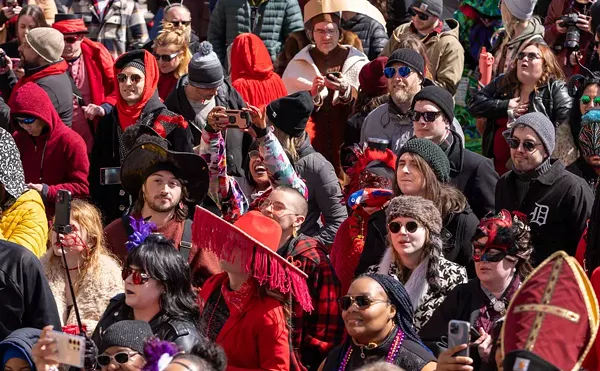Where else can a metro Detroiter take in sculpture by de Kooning, smoking lips by Wesselmann, a four-paneled piece by Roy Lichtenstein, weird new contemporary work by Tony Matelli, furniture designed by Charles and Ray Eames and Saarinen, the abstract geometry of Harry Bertoia’s metalwork, the blatant realism of Duane Hanson’s “Body Builder” and elegant craft, textile and metalworks by the likes of Maija Grotell and Paul Manship?
Yes, it’s a bit of a drive for those living in Detroit. And yes, it’s a bit refined in its artistic sensibility, leaving grungy south-side Detroiters feeling, well, so grungy. That said, Cranbrook Art Museum offers probably the best collection of modern and contemporary art in metro Detroit, in a setting of beautiful grounds, gardens, sculpture and elegant architecture that takes the soul away to a place of solitude.
This weekend the museum will, for the first time, present a complete overview of its permanent collection of art, architecture and design to commemorate its 100th anniversary. The museum’s show, dubbed 100 Treasures of Cranbrook Art Museum, should be a tremendous experience. Since George and Ellen Booth founded the Cranbrook Educational Community in 1904, the top-dollar private school, its elite graduate art and architecture program and the museum itself have consistently developed and shown the best in contemporary art in southeast Michigan. For Cranbrook’s anniversary, the museum will present 100 of its most cherished pieces.
100 Treasures will reaffirm the world-class quality of the museum’s permanent collection,” says the museum’s press material. The show will span the entire main level of the museum and will include work in all mediums, including printmaking, graphic design, fiber, glass, ceramics and painting.
The works in Cranbrook’s collection include national and international artists. More than half of the 82 artists who will show are related to Cranbrook in some fashion.
Two new works were acquired by the museum to debut at the anniversary show. “The Hunter,” by Tony Matelli, and “Candalabrum: Seven Fragments,” by metalsmith Myra Mimlitsch-Gray. Both are graduates of Cranbrook Academy of Art, and have achieved wide acclaim for their work.
Gary Griffin, head of metalsmithing at Cranbrook, says that Mimlitsch-Gray subverts traditional craft practices to challenge cultural norms and art history conventions.
Matelli’s piece is a bizarre lifelike sculpture of a man in red pajamas apparently abandoned on a rock formation in the middle of the sea. The man is looking out onto the horizon with a strained expression and his finger to his lips, wondering what to do. “The Hunter” is one piece of a three-part allegorical self-portrait exhibited last year in Paris, Toronto and New York. Matelli’s lifelike caricatures “depict the foibles of human nature and the personality disorders characteristic of our time,” says museum spokeswoman Felicia E. Molnar.
Another highlight is a painting by Zoltan Sepeshy, not seen for decades, called “Industrial Detroit.” Sepeshy was director of the Cranbrook Academy of Art from 1941 to 1966.
Matelli will present an artist’s talk on Saturday, Dec. 13, at 1 p.m. in the deSalle Auditorium. The show runs Dec. 13, 2003-March 28, 2004 at the Cranbrook Art Museum (39221 N. Woodward Ave., Bloomfield Hills; call 248-462-7262 for more information). Selected works will remain on view in the Main Gallery throughout the anniversary year.
Lisa M. Collins is the arts editor of Metro Times. E-mail [email protected]





